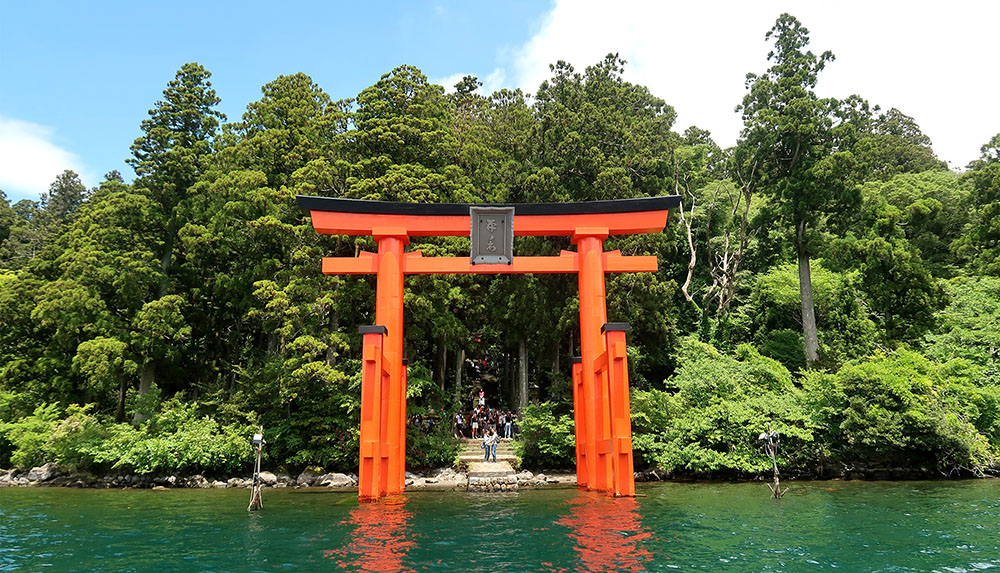Introduction
Hakone Shrine (箱根神社, Hakone Jinja) is nestled at the foot of Mount Hakone, along the shores of Lake Ashinoko. It’s the most renowned Shinto sanctuary in the Hakone region. This shrine, hidden within dense forests, is famous for its majestic torii gates, especially the grand torii standing in the lake, which forms one of Hakone’s most iconic views.
Key Information
- Location: 80-1 Motohakone, Hakone, Ashigarashimo District, Kanagawa 250-0522, Japan
- Highlights: Lakeside torii gate, serene forest path, Mototsumiya (original shrine)
- Best time to visit: Open year-round, especially beautiful in spring and autumn
- Admission: Free
- Access: About 35 minutes by bus from Hakone-Yumoto Station
Rich History
Hakone Shrine was founded in 757 CE by the Buddhist priest Mangan. Initially built at the summit of Mount Hakone, it was relocated to its current site in 1667. The shrine is dedicated to three deities: Ninigi-no-Mikoto, Konohanasakuya-hime, and Hoori-no-Mikoto. These deities are revered as the guardians of the Hakone region and have been worshipped by local residents for generations.
Main Attractions
Lakeside Torii Gate
The vermilion-colored great torii gate standing in Lake Ashinoko is Hakone Shrine’s most iconic landmark. This gate stands 16 meters tall and weighs about 1.8 tons, built in 1952. Whether shrouded in morning mist or bathed in the glow of the setting sun, the lakeside torii presents a mystical beauty that’s a favorite among photographers. Visitors can take a boat ride to admire this spectacle up close, experiencing the perfect blend of the sacred and natural worlds.
Approach and Stone Steps
The approach from the lakeside to the main shrine buildings is about 1 kilometer long, lined with ancient stone steps and moss-covered stone lanterns. The path is flanked by tall cedar trees, creating a tranquil green tunnel. Walking along this historic path feels like stepping back in time. It’s especially atmospheric after rain or on misty days when the whole approach is enveloped in a mysterious ambiance.
Main Shrine Buildings and Sacred Horse Stable
After climbing hundreds of stone steps, visitors reach the main shrine buildings. The architecture is elegant and features intricate carvings, showcasing the essence of traditional Japanese building techniques. Near the main hall, there’s a sacred horse stable housing a statue of a white horse. It’s said that touching the horse brings good luck, so there’s often a line of visitors waiting for their turn. The shrine area offers different beautiful scenes throughout the year – cherry blossoms in spring, vibrant autumn leaves, and sometimes a blanket of snow in winter.
Mototsumiya (Original Shrine)
Mototsumiya is located at the summit of Mount Komagatake and represents the original site of Hakone Shrine. Visitors can take the Hakone Komagatake Ropeway to reach the summit, where they can not only pay respects at Mototsumiya but also enjoy spectacular views of Lake Ashinoko and Mount Fuji. Although smaller in scale, Mototsumiya attracts many visitors due to its unique location and historical significance.
Best Time to Visit
Hakone Shrine is open year-round, with each season offering its unique charm:
- Spring (March-May): Cherry blossoms line the approach
- Summer (June-August): A cool retreat with lush greenery
- Autumn (September-November): Spectacular fall foliage
- Winter (December-February): Possible snow scenes, offering a different kind of beauty
It’s advisable to avoid Japan’s Golden Week (late April to early May) and New Year period when it’s most crowded. Visiting in the early morning or late afternoon not only means fewer crowds but also the chance to enjoy enchanting misty mornings or beautiful sunsets.
Getting There
- From Tokyo:
- Take the Odakyu Line from Shinjuku Station to Hakone-Yumoto Station (about 85 minutes)
- Transfer to the Hakone Tozan Bus (H Line) at Hakone-Yumoto Station and get off at Moto-Hakone Port (about 35 minutes)
- Walk 5-10 minutes from Moto-Hakone Port to reach the shrine
- Using the Hakone Free Pass:
- Purchase a Hakone Free Pass for unlimited use of local transportation
- Covers round-trip tickets from Shinjuku to Hakone and local buses, cable cars, etc. in the Hakone area
- By Car:
- About 2 hours drive from central Tokyo via the Tomei Expressway
- Paid parking available near the shrine
Hours and Fees
- Hours: Open 24 hours
- Admission: Free
- Komagatake Ropeway (for Mototsumiya): 1800 yen round trip (discounts available with Hakone Free Pass)
Visitor Tips
- Wear comfortable shoes as there are many steps to climb
- Bring some small change for purchasing amulets or ema (wooden prayer plaques)
- Visit in the morning for a quieter experience
- Don’t miss the chance to touch the sacred horse for good luck
- If time allows, take the ropeway to Mototsumiya for panoramic views
- Respect local customs by maintaining a quiet demeanor in the shrine area
Official Website
Conclusion
Hakone Shrine is not just a historically significant religious site but also a tourist destination that beautifully blends natural scenery with cultural heritage. Whether you’re strolling along the serene forest path or admiring the majestic lakeside torii, the experience is sure to leave a lasting impression. When visiting Hakone, don’t miss this opportunity to cleanse your spirit and immerse yourself in the charm of traditional Japanese culture. Embark on a journey to Hakone Shrine and let your soul be purified and elevated in this tranquil and sacred land.
